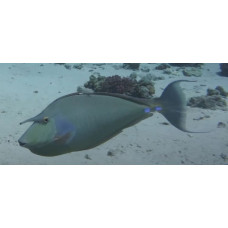Latin name
Naso unicornis
Other names
Short-nose unicornfish
Identification
The body is elongated, compressed at the sides. The depth of the body varies from about 2.0 in SL (juveniles) to 2.4-2.6 in SL (adults). The dorsal profile from the snout to the horn is straight, at an angle of about 45°. Caudal peduncle with 2 large fixed bony keel plates in adults, absent in juveniles. Adult head with characteristic horn projecting forward above the eyes. This becomes longer with age and is absent in juveniles.
Features of fish fins
Dorsal spines: 6; Dorsal soft rays: 27-30. Anal soft rays: 27-30. Anal fin has 2 barb rays, small anterior barb ray absent. Pelvic fins have 1 barbed and 3 soft rays. Caudal fin pointed in juveniles, truncated with filiform blades in adults.
Fish colouring
Body yellowish-olive gray dorsally, paler ventrally, with blue peduncular plates and keel spines; lips whitish or blue; blue area sometimes present around pectoral fin; dorsal and anal fins yellowish with narrow blue border; caudal fin orange to grey in lower part, with broad pale greenish posterior border, caudal filaments edged with blue; a transitional colour phase is a patchy pale greenish area under dorsal part of dorsal fin, narrowing and ending under pectoral fin.
Distribution
The species is found throughout the Indian and Pacific Oceans, from the Red Sea to the coasts of Japan, the Rapa Islands, Hawaii, the Tuamotu and the Marquesas Islands.
Habitat
Benthopelagic species. Offshore coastal fish inhabiting depths from 5 to 80 m. Adults stick to reef slopes and quiet lagoons. Juveniles are usually found in small groups in shallow waters. A tropical species that prefers temperatures between 26°C and 29°C.
Size
Maximum length: 70.0 cm. Normal length: 50.0 cm. Maximum stated age: 55 years.
Behavior
Usually found in small groups. Sometimes solitary. Mainly diurnal.
Food and feeding habits
Feeds mainly on brown algae.
Reproduction
Pair spawning has been observed. In some areas they have been observed migrating in schools around the outer edges of the reef and spawning on both full and new moons.
Fishing
Often caught in the wild for commercial aquariums.
Relationship with a person
There have been reports of ciguatera poisoning from consumption.
A popular marine aquarium species.
| Classification | |
| Phylum | Chordata |
| Class | Actinopterygii |
| Squad | Acanthuriformes |
| Family | Acanthuridae |
| Genus | Naso |
| Species | N. unicornis |
| Features | |
| Conservation status | Least Concern |
| Habitat | Pelagic |
| Life span, years | 55 |
| Maximum body weight, kg | No information |
| Maximum length, cm | 70 |
| Sailing speed, m/s | No information |
| Threat to people | Not edible |
| Way of eating | Bentophage |
Bluespine unicornfish
Tags: bluespine unicornfish



